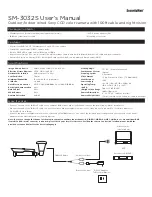
35-3001A-01-03 Methane Sample-Draw Detector • 19
6. Use the following formula to determine the correct test points output for the calibrating
sample.
Output (mV) = (calibrating sample/fullscale) X 400 + 100
For example, with a calibrating sample of 50% volume and a fullscale setting of 100% volume,
the correct output is 300 mV.
300 (mV) = (50/100) X 400 +100
Setting the Zero Reading
1. Connect the sample tubing from the demand flow regulator to the sample-draw detector’s inlet
line.
This step is not necessary if you verified a fresh air environment earlier in this
procedure.
2. Allow the sample-draw detector to draw sample for one minute.
3. Verify a voltmeter reading of 100 mV (± 2 mV).
4. If necessary, use a small flat-blade screwdriver to adjust the zero potentiometer until the
voltmeter reading is 100 mV (± 2 mV). If you used a zero air calibration cylinder to set the
zero reading, proceed to step 5. If you verified a fresh air environment, proceed to the next
section, Setting the Response Reading.
5. Disconnect the sample tubing from the inlet line.
6. Unscrew the regulator from the zero air calibration cylinder.
Setting the Response Reading
1. Screw the regulator into the methane calibration cylinder.
2. Connect the sample tubing from the demand flow regulator to the sample-draw detector’s inlet
line.
3. Allow the sample-draw detector to draw sample for one minute.
4. When the reading on the voltmeter stabilizes, verify that the reading matches the response
reading (±2 mV) you determined earlier.
5. If necessary, use the span potentiometer on the amplifier to adjust the reading to match the
correct response reading.
6. Disconnect the sample tubing from the inlet line.
7. Unscrew the regulator from the methane calibration cylinder.
Returning to Normal Operation
1. Wait approximately one minute to allow the methane reading to stabilize.
2. Remove the voltmeter leads from the amplifier test points.
3. Close the housing door.
4. Follow the instructions in the controller’s operator’s manual to exit the calibration mode.
5. Store the components of the calibration kit in a safe and convenient place.

































